Soldier Story: Torao Hayashi
Soldier Story
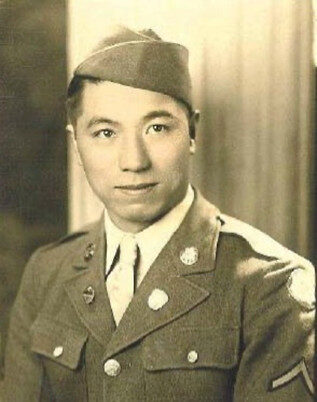
Torao Hayashi
Private First Class
100th Battalion, B Company
442nd Regimental Combat Team
Torao Hayashi was born on January 24, 1914, in Sacramento, California, to Ichimatsu and Yoneyo (Ikeda) Hayashi. He was the second of eleven children. His siblings were: brothers John Kazumi, Masuo, Masao Roy, and sisters Helen Hisako, Michiye Arlene, Yoshiko Louise, Sueko Barbara, Tomiko Jane, Natsuye Ruth, and Ruby.
Father Ichimatsu was the son of Kumetaro and Yuki (Ito) Fukushima. He was the second son and had four sisters. He first arrived in the US at Honolulu, Territory of Hawaii, in 1898 from Yamaguchi Prefecture. He arrived in Tacoma, Washington, in 1906 and by 1910 was working on a truck farm on J Street Road in Brighton Township, Sacramento County. He traveled to Tacoma to meet the ship carrying his betrothed, Yoneyo Ikeda, the daughter of Kichizo and Tsuyo (Muranaka) Ikeda, from the village of Marifu, Kuga District, Yamaguchi Prefecture. They were married on March 27, 1911, just after her arrival on March 23 on the Tacoma Maru. Ichimatsu changed the family surname to Hayashi before their first child was born on June 4, 1912. The family believes that he may have done this in order to inherit land in Japan.
In 1918, the family lived at 1402 5th Street in Sacramento, and Ichimatsu operated his truck farm at Front and Y Streets near the Sacramento River.
By 1930, the family had moved to Jackson Road in Perkins on the east side of Sacramento. Ichimatsu was a truck farmer. Torao graduated from Sacramento High School in 1931. In 1940, the family was still living in the same house. Brother John K. was married and his wife Lorraine also lived in the home. John was his father’s partner in farming and Torao worked for them.
Torao signed his draft registration card on October 16, 1940, Local Board No. 28, 1700 K Street, Sacramento. He was living with his family on Jackson Road, address P.O. Box 25, Perkins. His brother John was his point of contact and his employer on the farm. Torao was 5’4” tall and weighed 135 pounds.
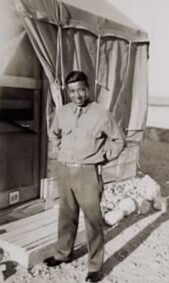
On March 21, 1941, Torao Hayashi enlisted in the U.S. Army in Sacramento. He was sent for basic training at Camp Roberts, Monterey and San Luis Obispo Counties, California.
He was then stationed at Fort Bliss, El Paso, Texas, with the 8th Service Command. The unit, nicknamed “Texas Power Wagon,” was responsible for Arkansas, Louisiana, New Mexico, Oklahoma, and Texas. The headquarters was at Fort Sam Houston in August 1942 and later moved to Dallas.
Right: Pfc. Hayashi at Fort Bliss, 1942
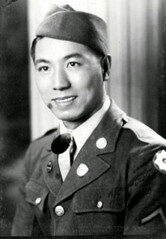
The Hayashi family was evacuated to the Pinedale WCCA Assembly Center in Fresno in the spring of 1942. They were incarcerated at Poston Camp 2, Colorado River WRA in Arizona. The family lived in Unit 2-208-2-CD. Son Masuo died of cardiac failure while at Poston, on January 3, 1944, five days after his 24th birthday.
Left: Hayashi while stationed at Fort Bliss
Most of the family members were released to Sacramento on April 2, 1945. John and wife Lorraine lived in Unit 2-208-13-A and two children of their children were born there. They were released to Tooele, Utah, for employment on December 14, 1944.
In early 1944, Torao Hayashi was sent to Camp Shelby, Mississippi, for combat training. That summer he was given a short furlough to visit his family at Camp Poston in Arizona.
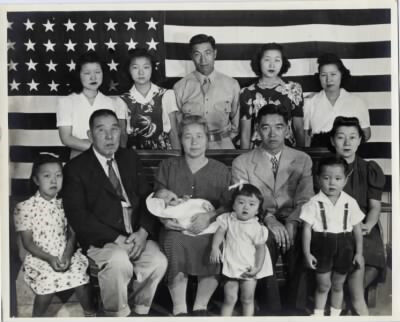
Above: On his last visit to see family at Poston, 1944. Front: Ruby, Ichimatsu, Yoneyo (holding Ronald), Sharon, John, Dennis, Lorraine. Back: Barbara, Ruth, Torao, Jane, Louise
After returning to Camp Shelby, Hayashi was sent as one of 672 replacements to the 442nd Regimental Combat Team in Italy. The 442nd had been in Italy since May 28, 1944, and had fought in the Rome-Arno Campaign. They were relieved from the front lines on September 6 and moved to a bivouac at Castiglioncello. On September 10 they were trucked to Piombino and embarked on Liberty ships to Naples. After arrival, the Combat Team bivouacked outside of the city.
On September 18, Pfc. Torao Hayashi arrived as one of the 672 much-needed replacement troops and was assigned to 100th Battalion, B Company. The new arrivals had to be trained and integrated into their companies over the next 10 days. Finally, on September 27, the 442nd left on the transport ships Thurston, Dickman, Chase, and Henrico for France.
They arrived at Marseilles on September 29 after a 2-day voyage, and bivouacked at nearby Septèmes prior to traveling over 500 miles north by truck or rail boxcars to the Vosges Mountains – where they joined in the Rhineland-Vosges Campaign as part of the Seventh Army.
The Combat Team arrived at Charmant-devant-Bruyères on October 11. On October 14, the 442nd began moving into position in the late afternoon preparing for the assault on the German-held hills surrounding the important road and rail junction of Bruyères.
After liberating Bruyères on October 18, followed by the neighboring villages of Biffontaine and Belmont, they were given a couple of days to rest in Belmont. On October 24, Torao wrote to his sister Louise at Poston. In his letter he said that he was “doing swell and still kicking.” He also referred to the family photo that she had sent to him at an old address and that it would be quite some time before he received it. He signed off with “Well, that’s all for this time – till again, Torao.”
After a day at Belmont, the 442nd was told that the following morning they would be heading out to rescue the 1st Battalion of the 141st (Texas) Regiment. Despite numerous attempts at rescue, this battalion remained surrounded on three sides by the enemy after advancing beyond its support.
Following is a description by I Company Medic Victor Izui of what the 442nd encountered, after the costly and exhausting battles for Bruyères and Biffontaine, as they set out on their mission – still in their summer uniforms:
To get to them, we encountered the most God-awful terrain and weather in the dark, jungle-like Vosges forest – a series of unmaneuverable, long, narrow ridges; cold rain and more cold rain; well-camouflaged, well dug-in, tenacious enemy we couldn’t see; water-logged foxholes and soggy combat boots that produced trench feet; digging dugouts no matter how tired we were in order to survive devastating nightly barrages and tree bursts…a foolhardy general [Major General John E. Dahlquist] who came right up to our lines, goading us to get up and charge…three days of slow, tedious tree-to-tree fighting with no sleep; forcing down cold, dry meat hash and crackers with cold, stale water…
On October 27, the men set out before sunrise, marching in columns with each man holding onto the pack of the man in front of him as they could not see in the pitch-dark night. By 2:00 p.m. the 100th was in position on the right of the line with 2nd Battalion on the left and 3rd Battalion in the center. The attack moved very slowly, meeting heavy resistance. The fighting was severe and after a counterattack was broken, they dug in for the night. By the end of the next day, October 28, the 100th and 3rd Battalions had advanced about 500 yards and captured 70 prisoners.
It was on this day, October 28, that Pfc. Torao Hayashi was mortally wounded by artillery shrapnel in his back and side. He was taken to an aid station where he died. He was buried at Épinal American Military Cemetery south of Bruyères.
For his military service, Private First Class Torao Hayashi was awarded the: Bronze Star Medal, Purple Heart Medal, Good Conduct Medal, American Campaign Medal, European-African-Middle Eastern Campaign Medal with one bronze star, World War II Victory Medal, Distinguished Unit Badge, and Combat Infantryman Badge. He was posthumously awarded the Congressional Gold Medal on October 5, 2010, along with the other veterans of the 442nd Regimental Combat Team. Conferred by the U.S. Congress, the award states: “The United States remains forever indebted to the bravery, valor, and dedication to country these men faced while fighting a 2-fronted battle of discrimination at home and fascism abroad. Their commitment and sacrifice demonstrates a highly uncommon and commendable sense of patriotism and honor."
On December 12, 1944, an obituary for Pfc. Hayashi was printed in the Sacramento Bee. Two days later, Director Dillon S. Myer of the War Relocation Authority in Washington DC wrote the following letter to Torao’s parents:
Three years of war have brought heartache to many in our population. While there is little I can say today that will assuage your overwhelming grief, in the months to come you may think back upon my message with some small comfort. For I am proud of your son; proud that he was an American who had the strength and courage to fight for his country in her great crisis; proud that he was willing to give his blood as his last great measure of devotion. I congratulate you as parents who instilled these manly qualities in your son and prepared him to meet the greatest test of our times.
In a special sense, your son fought to win the war against two foes, the enemies of democracy abroad, and the enemies of democracy at home who use race and ancestry to confuse and defeat the real meaning of America. It is my sorrow that he could not have lived to see his bravery, his sacrifice and his suffering to bear fruit in a better world for all peoples.
The family also received a certificate bearing the Great Seal of the United States and signed by President Franklin D. Roosevelt. It reads:
In grateful memory of Private First Class Torao Hayashi, A.S. No. 39078621 who died in the service of his country in the European Area on October 28, 1944. He stands in the unbroken line of patriots who have dared to die that freedom might live, and grow, and increase its blessings. Freedom lives, and through it, he lives – in a way that humbles the undertakings of most men.
After the war, the US began closing many of its overseas wartime cemeteries. Families were given the choice of having their loved one returned home if they wished. The Hayashi family chose to have Torao returned to California. His remains were returned and interred at East Lawn Cemetery in Sacramento, where many other Hayashi family members are buried.
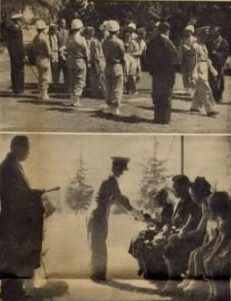
Left: Burial service for Pfc. Hayashi at East Lawn Cemetery, 1948
On July 2, the family held a memorial service for Torao at the Buddhist Hall, 418 O Street. This was followed by graveside services under the auspices of Veterans of Foreign Wars (VFW) Nisei Post 8985, whose members also gave a 21-gun salute. Hayashi was survived by his parents, brothers John and Roy, and sisters Arlene Tsukamoto (Mrs. Sam K.), Louise Kubo (Mrs. Yoshi), Barbara, Tomiko Jane Noda (Mrs. George S.), Ruth, and Ruby. His sister Helen Masuhara (Mrs. Shigeichi) predeceased him on January 19, 1941.
Researched and written by the Sons & Daughters of the 442nd RCT with assistance by Pfc. Hayashi’s niece, who is a 442nd Sons and Daughters member, in 2025.